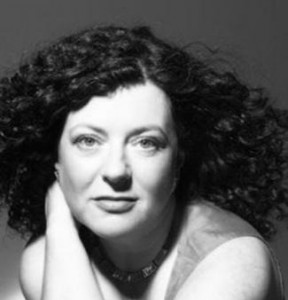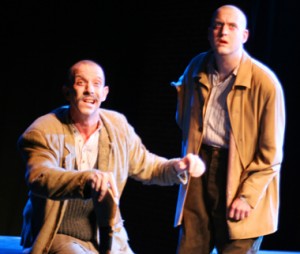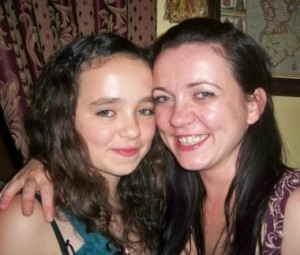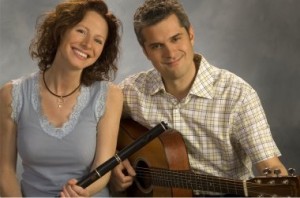Even through pints of amniotic fluid and layers of mom, an unborn baby hears music. Studies show that a year after they’re born, babies recognize and prefer the music they were exposed to in the womb.
That may explain why Irish singer-songwriter Fil Campbell was so drawn to the songs of Delia Murphy, who died while Campbell was still a child in Beleek, County Fermanagh. “Delia Murphy’s was the music I grew up with,” says Campbell, who is bringing her award-winning show, “Songbirds: The First Ladies of Irish Music” to the Irish Center in Philadelphia on Friday, October 2.
From a very early age, Delia Murphy songs were the ones she remembers her parents singing. Murphy’s recordings were always on the record layer or the radio when she was young. So it was natural for Campbell to add the tunes she may have heard before birth to her repertoire when she started singing professionally at 16.
Before it was a road show and a CD, “Songbirds” was a series that Campbell co-produced and hosted which aired on the RTE network in Ireland to great acclaim. It chronicles the life of Murphy, a child of wealth from County Mayo, and four other female singers who each left indelible impressions on successive generations of Irish from the1930s to the 1960s.
There was Margaret “Maggie” Barry, a ribald traveler who left an unhappy home to sing on the streets and market fairs and later influenced a young folk singer from Minnesota who called himself Bob Dylan and Irish balladeer Luke Kelly.
Bridie Gallagher becameknown as “the girl from Donegal” after her eponymous debut LP in the mid-1950s. She sold millions of records over the last half of the twentieth century and influenced countless singers, including Daniel O’Donnell.
Ruby Murray first appeared on television as a singer at the age of 12 and made her first recording just a few years later. Murray achieved dazzling success in 1955 when five of her songs appeared on the Top 20 in the same week. It’s a feat that has never been beaten, and was only matched this past July—posthumously–by Michael Jackson.
But Murray, the sweet-voiced girl from Belfast whose biggest hit was the unforgettable tune, “Softly Softly,” came to a hard end. She died at 61 of liver cancer after years of alcoholism.
Mary O’Hara’s was a life tailor-made for a Hallmark movie. Married at 21, a widow 15 months later, this harpist with the crystalline soprano voice joined an English monastery in 1962 and lived there for 12 years. She made a comeback in 1972 and quickly sped tothe top of the world again, appearing solo at Carnegie Hall in the late ‘90s. In his autobiography Memoirs of an Irish Troubadour, Liam Clancy writes that the music of Mary O’Hara inspired and influenced him and others of the Folk Revival period of the 1960s and ‘70s.
Their voices and styles—and clearly, their lives–are as different as chalk and cheese, but together they form the nostalgic soundtrack of an Ireland long gone.
The Ireland of Fil Campbell’s childhood is also long gone. “We lived out in the country and there was no cinema or anything. All we had for entertainment were ceilis or going to a relation’s house where everyone would do their party piece,” she recalls. “There was a lot of music in my family. My father was a really good singer and his brother and sister were musical too. His brother, Gerry Campbell, was a wonderful accordian player and he spent most of his life in Yonkers, NY. On my mother’s side of the family, they were all in ceili bands.”
Once she went to school,Campbell got her second dose of music education. “I come from the little village of Belleek right on the border with Donegal,” she says. “The first day I went to school in Eniskellin, the nuns made everybody as first years sing or dance, and if you showed any ability at all they just instantly handed you instruments and you got on with it.”
She started performing in her teens, then bounced between jobs on the periphery of music—promoting entertainers, doing radio—before taking up music as a career. “In the beginning, I did mostly my own songs,” says Campbell. “Then after attending the North American Folk Alliance event in the Catskills a few years ago I started thinking about doing more traditional music.”
She immediately thought of Delia Murphy. “I wanted to do an album of Delia Murphy songs. I thought she was an amazing woman and such fun.”
And, like the other Songbirds, she had a remarkable back story. As she does in her show, let Campbell tell it:
“Delia’s father grew up during the famine in Ireland and like a lot of people he emigrated to America, making it to the west coast at the tail end of the Gold Rush. He had vowed when he left Ireland to buy the house the landlord lived it. He wound up making his fortune in America, managing a silver mine, and came back to Ireland and bought the house, with the result that the family was brought up as upper class citizens. They had a big estate, with hounds kept for the hunt, and they mixed with royalty and film stars. Delia grew up wth an incredible panache about her. She was college-educated which was unheard of for a Catholic girl. Though she came from a gentrified background, she had a broad west of Ireland accent (she was the first Irish singer to record in her own accent) and she sang songs of the common people and wound up marrying an ambassador. ”
Ultimately, of course, Campbell wound up collecting songs from other remarable female singers she’d heard growing up. She calls them traditional, though she knows not everyone will agree.
“It’s a really gray area,” she says. “There’s so much snobbery about Irish traditional music. Every traditional song was written at some point. Somebody wrote it. A lot of the songs associated with these women are known by the derogatory term “come-all-ye,” referring to songs that have a chorus that goes ‘come all ye, sing along with me.’ It’s a song everybody knows and can join in. Some of the songs, like ‘The Boys from the County Armagh’ and ‘WildRover’ are come-all-yes. Everybody knows them so everyone sings along.”
This is a bad thing? Campbell doesn’t think so. She encourages it. “We want everyone to have a good time,” she laughs. “It’s a light show. We don’t take ourselves seriously.”
here are times, she says,she thinks, “four years and here I am still Songbirding.” The show has played to packed houses in Ireland, England, and Germany, and the Irish Center show is the first time she’ll be performing it for American audiences. “I’m a bit nervous about it but it went well everywhere else,” she says.
“It’s great fun. I love doing this material–despite the fact,” she laughs, “that I’m closet rocker Bonnie Raitt in my head!”





